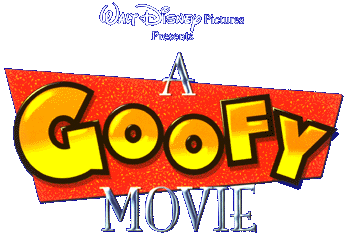

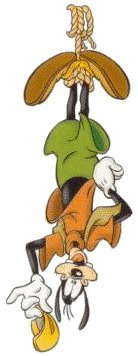
Directed by: Kevin Lima (Tarzan)
Written by: Jymn Magon and Chris Matheson
Music by: Carter Burwell, Tevin Campbell,
Patrick DeRemer, Jack Feldman, Roy Freedland and Tom Snow
Released on: April 7, 1995
Running Time: 78 minutes
Box-Office: $35.348 million in the U.S.
Goofy Goof... Bill Farmer
Maximillian 'Max/Maxy' Goof... Jason
Marsden
Peter Pete... Jim Cummings
P.J. Pete... Rob Paulsen
Principal Mazur... Wallace Shawn
Stacey... Jenna von Oÿ
Bigfoot... Frank Welker
Lester: Main Possum Park Emcee... Kevin Lima
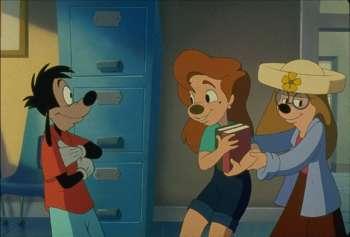 |
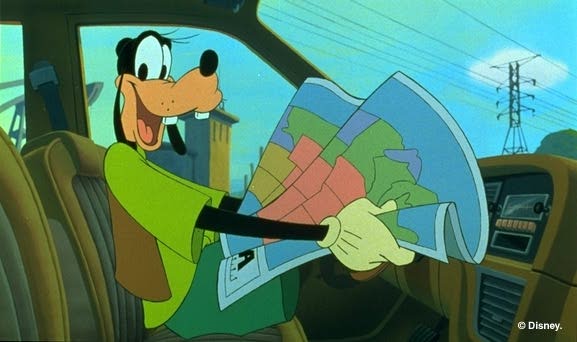 |
 |
![]() The movie is based on
the characters portrayed in the Disney Afternoon show Goof Troop:
Goofy, Max, Pete and P.J.
The movie is based on
the characters portrayed in the Disney Afternoon show Goof Troop:
Goofy, Max, Pete and P.J.
![]() Art Babbit, the animator
credited for developing The Goof, remarked that "Goofy was the kind of
character that thought very hard and very long about everything he did
- and then he did it wrong!"
Art Babbit, the animator
credited for developing The Goof, remarked that "Goofy was the kind of
character that thought very hard and very long about everything he did
- and then he did it wrong!"
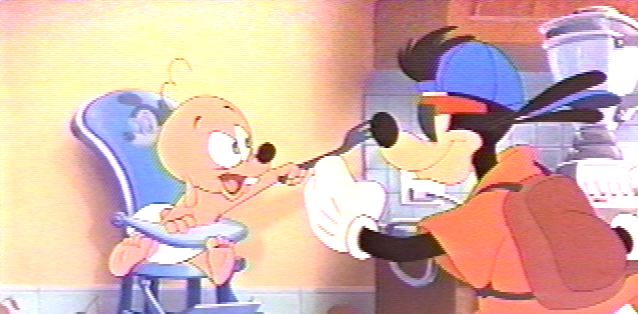
![]() During the Powerline Concert, Mickey Mouse can be spotted in the crowd
in the lower left portion of the crowd shot immediately after the Stage
manager is thrown into the DiamondVision screen. Also during the "Stand
Out" reprise, Max 'boards through a house in which a baby is reaching toward
a socket with a fork. On the back of the baby's high chair is a certain
fa"mouse" individual.
During the Powerline Concert, Mickey Mouse can be spotted in the crowd
in the lower left portion of the crowd shot immediately after the Stage
manager is thrown into the DiamondVision screen. Also during the "Stand
Out" reprise, Max 'boards through a house in which a baby is reaching toward
a socket with a fork. On the back of the baby's high chair is a certain
fa"mouse" individual.
![]() There are several references
to Disney characters, including a game of 20 Questions, ("Man or woman?"
"Man..." "Hmm... Walt Disney?" "Right...") Max saying Goofy's 'best buddy'
is Donald Duck, and a hitch-hiking Mickey Mouse (accompanied by Donald)
having a small part in the song "On The Open Road"
There are several references
to Disney characters, including a game of 20 Questions, ("Man or woman?"
"Man..." "Hmm... Walt Disney?" "Right...") Max saying Goofy's 'best buddy'
is Donald Duck, and a hitch-hiking Mickey Mouse (accompanied by Donald)
having a small part in the song "On The Open Road"
![]() During the song "On
The Open Road" Goofy's key chain has the famous Walt Disney's logo "D"
on it.
During the song "On
The Open Road" Goofy's key chain has the famous Walt Disney's logo "D"
on it.

![]() When Max is singing on stage at school they flip to a scene that shows
a carboard cut-out of "Ariel-The Little Mermaid"! It cannot be seen in
the VHS version because it was formatted to fit the screen.
When Max is singing on stage at school they flip to a scene that shows
a carboard cut-out of "Ariel-The Little Mermaid"! It cannot be seen in
the VHS version because it was formatted to fit the screen.
![]() At the end of the credits,
you can hear the familliar voice of Goofy screaming.
At the end of the credits,
you can hear the familliar voice of Goofy screaming.
![]() When the film came out,
voice actor Bill Farmer joked in an interview that Mrs. Goof had taken
off for the mall one day and never come back.
When the film came out,
voice actor Bill Farmer joked in an interview that Mrs. Goof had taken
off for the mall one day and never come back.
![]() Hot of the commercial
success of A Goofy Movie, Kevin Lima was chosen by Disney to helm
what was then being developed as a 'B' feature... Tarzan.
Hot of the commercial
success of A Goofy Movie, Kevin Lima was chosen by Disney to helm
what was then being developed as a 'B' feature... Tarzan.
GOOFY GOOF BIOGRAPHY from Disney.com
For more than 70 years, Goofy -- the awkward, toothy, curious, and good-spirited Everyman of the Disney cartoon characters -- has been a top performer in every medium, beginning with a bit part in a Disney short, and eventually becoming a major media star in print, television, theme parks, and a variety of merchandise.
Why is Goofy so enduringly popular? Primarily, it's because he's funny. In any language, with any age group, Goofy's antics always communicate. But, beyond that, his popularity is connected to the source of his humor. We generally see Goofy ever-valiantly attempting things that we ourselves might fear, "goofing" them up in a way that we're a little afraid we might, and yet shining through it all with qualities to which we most aspire. Goofy is cheerful, eternally loyal, and always willing to help his friends. He has a gentle, childlike innocence and wonder about the world around him. And, perhaps most important, Goofy always assumes the best about his fellow man.
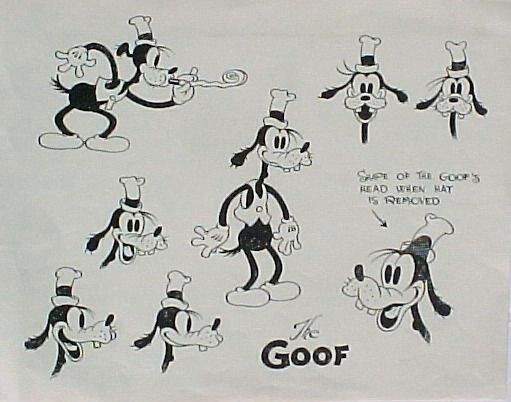 The
character whom we know today as Goofy first appeared six decades ago in
Mickey's
Revue (1932). Then a bit player (as an obnoxious "laugher" in a barnyard
audience), he sported whiskers and square spectacles and was called Dippy
Dawg.
The
character whom we know today as Goofy first appeared six decades ago in
Mickey's
Revue (1932). Then a bit player (as an obnoxious "laugher" in a barnyard
audience), he sported whiskers and square spectacles and was called Dippy
Dawg.
Walt often described the type of physical humor used in the Walt Disney Studio's cartoons as being "goofy," and with Orphan's Benefit (1934), that name officially stuck to this affable character. But Goofy's personality really began to take shape in the 1935 cartoon Moving Day, in which animator Art Babbitt built up Goofy's role and gave his character definition. And thus, a new Disney star was born.
The second half of the 1930s was the golden age of Disney cartoon shorts, as the Studio reached unprecedented achievements in personality animation. Goofy was teamed with Mickey and Donald in a variety of comedy situations that frequently ended in chaos. Cartoon shorts such as Lonesome Ghosts, Clock Cleaners, Boat Builders, Mickey's Service Station, and Mickey's Trailer looked at how each character reacted to similar circumstances. Goofy's first solo-starring vehicle was Goofy and Wilbur (1939). This short fully explored Goofy's emotional range as he shared a fishing trip with his grasshopper pal, Wilbur.
In the early 1930s, merchandising of the characters became a successful
and vital part of the Disney Studio. Mickey and Minnie were seen on most
of the products issued early on, followed by Donald Duck soon after. From
1935 on, Goofy began to appear on a wide range of merchandise objects,
albeit in a supporting role. Early merchandise appearances include novelty
playing cards (on the joker, naturally), tin toys, jigsaw puzzles, and
plush toys. As his motion picture and print popularity increased in the
'40s and '50s, Goofy was featured on merchandise lines of his own.
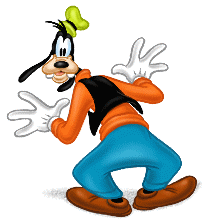
In 1941, Goofy began starring in a popular series of "how to" sporting
films (The Art of Skiing, How to Ride a Horse, etc.). In
these shorts, the Goof responds in pantomime to a droll professorial narrative,
the stodgy seriousness of the narrator playing in sharp contrast to Goofy's
clumsy demonstrations. The result is a hilarious visual depiction of "how
NOT to" accomplish the task being described. But, through it all, Goofy
remains undaunted, ready to move on to the next lesson. It is perhaps for
this series of nearly two dozen cartoons that Goofy's film career is most
fondly remembered.
In the l960s, Goofy was frequently cast in suburban settings as the "common man," occasionally with a wife and son, to showcase some of the pitfalls of modern living. In this unusual guise, he was often known as Mr. George Geef, and even shed his distinctive voice for some of these roles. This mature role for Goofy utilized his skills as an actor, rather than playing upon his traditional persona.
Goofy's multimedia status was launched early in his career, in 1933, with appearances in daily Mickey Mouse comic strips, as a neighbor and occasional associate of Mickey in his activities. Because the needs of the daily and weekly Mickey Mouse strips quickly exhausted the situations, stories, and characters that had been created for the films, comic artist Floyd Gottfredson and his team of writers created new situations and adventures that, particularly in the case of Goofy, helped define and develop the characters and their personalities. Gradually, Mickey came to rely on Donald and Goofy as his boon companions. Today, 60 years later, Goofy is still enormously popular, and appears in comic books and comic strips published in 14 languages and 15 countries.
From 1933 onward, Goofy also appeared in many Mickey Mouse books as a member of "the gang," and over the years has been a consistent character in hardcover books in the United States, England, France, and Italy, to name a few.
Beginning in 1953, Goofy starred in his own limited series of comic-book adventures. In 1955, he became Super Goof, a super hero parody still popular today. He has also starred in comic spoofs of historical characters, literary and actual, including Rip Van Winkle and Leonardo da Vinci. Most recently, he starred in a limited comic series, Goofy Adventures, from Disney Comics.
 As the Walt
Disney Studios ceased regular production of short cartoons in 1956, the
classic cartoon characters were getting a new lease on life from the very
medium that led to the end of theatrical shorts -- television.
As the Walt
Disney Studios ceased regular production of short cartoons in 1956, the
classic cartoon characters were getting a new lease on life from the very
medium that led to the end of theatrical shorts -- television.
Mickey, Minnie, Donald, and Goofy could be seen regularly through the '50s, '60s, '70s, and '80s on several Disney television shows, including The Mickey Mouse Club, as well as Disneyland and its successors, Walt Disney Presents, Walt Disney's Wonderful World of Color, and The Wonderful World of Disney. Some of the episodes featured Goofy's classic cartoon appearances in newly created story frameworks, including The Goofy Success Story and Holiday for Henpecked Husbands.
Along with the rest of "the gang," Goofy has been an integral part of The Disney Channel since its inception in 1983. Classic Goofy cartoons have been featured daily on the Donald's Quack Attack and Mickey's Mouse Tracks programs, as well as Mouseterpiece Theater and such special shows as Goofy's Guide to Success and The Roots of Goofy.
During the 1980s, Goofy was often seen in the company of his friend Michael Eisner in the introductory segments for The Magical World of Disney network television program.
Goofy has been a consistent part of the home-video market since 1980. He appears in countless homes on Buena Vista Home Video's Walt Disney Cartoon Classics series of cassettes, including Here's Goofy and Mickey & the Gang, The Goofy World of Sports, Happy Summer Days, and Fun on the Job, as well as the Disney Mini-Classics Mickey and the Beanstalk and The Prince and the Pauper.
Goofy's positive, "I'll try anything" attitude was the focus of the 1980s Sport Goofy athletic programs. In a natural development from the "how to" series, Sport Goofy was named the official mascot of the French Olympic team, was endorsed by the German Sport Association, and was the mascot of the International Tennis Federation Junior World Tennis Championship. Sport Goofy was also a major merchandising character, featured on more than 30 different sporting outfits, as well as decorating a wide range of sporting accessories. His own anthem of confidence to young people, a song entitled "You Can Always Be Number One," was especially encouraging to those who didn't feel they excelled at sports. The Goof's message was that: It doesn't matter if you win or lose; just get up, try, and, most of all, have fun.
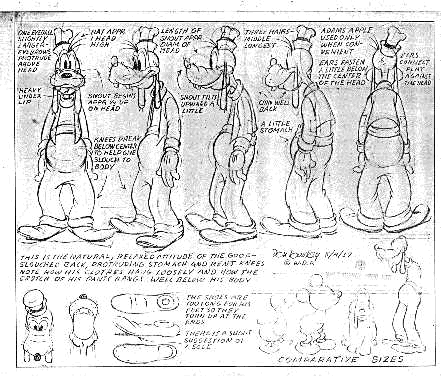 For
many years, Goofy has also been a recurring character in Disney educational
productions. His affable optimism and "how-NOT-to" way of doing things
make him a perfect subject for these productions, which are seen by millions
of young people in schools throughout the country.
For
many years, Goofy has also been a recurring character in Disney educational
productions. His affable optimism and "how-NOT-to" way of doing things
make him a perfect subject for these productions, which are seen by millions
of young people in schools throughout the country.
Goofy has also been on hand to personally greet his fans and friends at Disneyland Park, Walt Disney World Resort, Tokyo Disneyland, and Disneyland Paris. He stars in parades and stage shows, as well as strolling through the various parks and "goofing around" with guests. He has also performed in "Walt Disney's World on Ice" and in arena shows such as "Disney on Parade."
In 1992, Goofy became the first of the classic Disney "gang" (Mickey, Minnie, Donald, Daisy, Pluto, and Goofy) to star in a new television series of his own, with the premiere of Buena Vista Television's "Goof Troop" in September.
In 1995, attaining full superstar status, Goofy became a motion picture
star in his own film, A Goofy Movie, which featured the lovable
Disney goof trying to bond with his teenage son, Max, and showing him that
there's nothing really wrong with taking after dear old dad. An Extremely
Goofy Movie followed in 2000.
|
||||||||||||